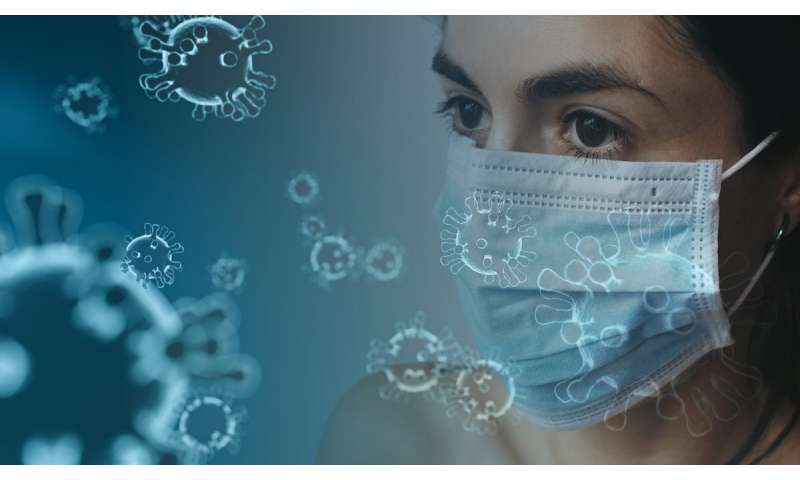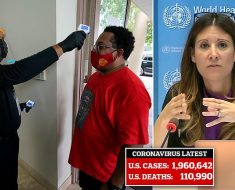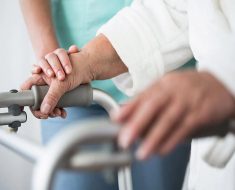
An easy-to-use algorithm can now be used to determine the risk of being infected by SARS-CoV-2 via aerosol particles from patients in indoor environments. It also estimates how protective measures such as wearing masks and ventilation reduce the risk. The model, developed by researchers at the Max Planck Institute in Chemistry in Mainz, uses parameters such as the size of the room, the number of people in it and their activity to estimate both the individual risk of COVID-19 infection and the risk of anyone in the room. The algorithm is publicly available via an input mask on the institute’s website. It calculates infection risk by micrometer size aerosol particles, but not by larger droplets in case of close contact with an infected person. The approach complements standard protection measures.
Even though experts have not yet reached full agreement, many assume that aerosol particles play an important role in the transmission of SARS-CoV-2 viruses. The aerosols are created when breathing, talking and singing. Unlike droplets, they don’t fall to the ground quickly, but can stay in the air for a long time and spread throughout the room. Indoor situations where many people are together for an extended period are particularly critical for infection with COVID-19. But how high is the risk of infection really? And how much can it be reduced by wearing face masks and active ventilation?
Researchers at the Max Planck Institute for Chemistry and the Cyprus Institute (Cyprus) have now published a study in which they present an easy-to-use spreadsheet algorithm to estimate the probability of COVID-19 infections through indoor aerosol transmission. The algorithm is publicly available, and can also be operated from website of the Max Planck Institute for Chemistry. You can enter various parameters such as room size, number of people and duration of stay at a particular location.
Various scenarios: Classroom, office, reception, choir rehearsal
The algorithm automatically calculates the probability of transmission if one person in the room is highly infectious both the individual risk of infection and that for any other person in the room. You can select different scenarios: a classroom, an office, a reception (or party) and a choir rehearsal. Experts can also use available fields for information such as the infective dose, the virus load of the infected person and the survival time of the virus in the air. The filter efficiency of face masks or the air exchange rate can also be flexibly entered.
“We want to make a contribution so that the likes of a school or an office can independently calculate how high the risk of infection is on their premises, and how effective each possible safety measure is,” says Jos Lelieveld, Director at the Max Planck Institute for Chemistry and first author of the study.
In their study, the scientists present the concept and assumptions on which the calculations are based. On average an adult inhales and exhales around 10 liters of air per minute. The researchers assume that the average dose for someone to become infected with COVID-19 is around 300 viruses or RNA copies per person. The calculation is illustrated by a school class in which no safety measures are taken: a 60 m2 classroom measuring 3 m from floor to ceiling, with 25 students aged ten and above attending six hours of lessons, where one of the students is highly infectious for two days.
According to the calculation, the probability that a particular person will become infected under these circumstances is just under 10%, but the probability that any person will become infected is over 90%. Infection is therefore almost inevitable. An individual with COVID-19 is usually highly infectious for a few days. In relation to all people who test positive for COVID-19, an average of around 20% is typically highly infectious. They are not to be confused with the so-called superspreaders, of which it is not well known how often they occur.
Variables allow individual use of the model
“Our calculations show that the risk of infection can be reduced by up to a factor of two by regular, active ventilation, and by a factor of five to ten by additionally wearing face masks,” adds atmospheric researcher Lelieveld. Taking the school class as an example, this means that if the windows are opened every hour, the probability can be reduced from 90 to 60%. In addition, if all students wear masks, the risk of infection drops to around 24%. If you enter in the website calculator that only half of the number of students are taking part in the lessons, the probability of transmission drops to 12%. At the same time, the individual risk drops from 10% to 1%.
The model only determines the risk of infection via the aerosol particles, which are so small that they remain in the air for a long time and are distributed throughout the room. It does not allow any statements about the risk of becoming infected via larger droplets that fall quickly to the ground over short distances, for example from coughing or sneezing.
In their publication, the researchers also address the uncertainties in the calculations. These are, for example, related to assumptions such as the survival time of the SARS-CoV-2 viruses in the air and the number of viruses that an infected person gives off. Another point of uncertainty is how many virus particles actually cause a COVID-19 infection, as this can vary between susceptible persons and cannot be directly measured. “Our assumptions are based on the current state of the science,” says Frank Helleis, physicist at the Max Planck Institute for Chemistry. “There are variables in the calculation. Hence it makes a difference if and how many people in a room will speak and sing or what exchange rate with outside air is applied,” says Helleis, who designed the algorithm.
Source: Read Full Article





